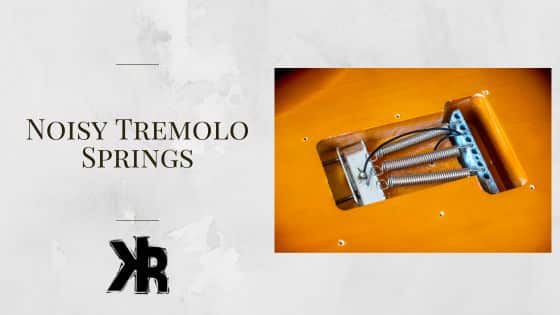Table of Contents
Noisy tremolo springs are a thorn in the side of many a guitarist. A persistent, unwelcome guest that overstays its welcome and disrupts the serene symphony of strings.
But, for every problem, there exists a solution, waiting to be discovered, eager to restore balance to the disrupted harmony. In the case of the pesky tremolo spring noise, the solutions are as varied and unique as the notes on a guitar.
From the humble rubber tubing to the innovative noiseless springs, each solution carries with it the promise of silencing unwanted noise.
In this Killer Rig article, we will navigate the intricate labyrinth of guitar mechanics, armed with nothing but our determination and a handful of everyday items. The road may be long and winding, but the reward, a noise-free guitar, is well worth the journey.
Understanding Tremolo Spring Noise
Tremolo spring noise is a very common issue among guitarists. This disruptive sound emanates from the tremolo springs of a guitar.
This noise can significantly affect the quality of the sound produced by the instrument. It quickly leads to a pretty frustrating experience instead of a musical one.
What is Tremolo Spring Noise?
Tremolo spring noise is characterized by a resonating sound that occurs when the guitar is played. This sound is often described as a loud creaking or a discordant hollow hum, which can interfere with the music being played.
The more aggressively you play your guitar, the worse this sound can get. It trails your music in a way that adds a noise that is just loud enough for a person to detect that something isn’t right.
Causes of Noisy Tremolo Springs
The primary cause of tremolo spring noise is the rubbing of each loop when they are stretched or are recoiling. If you look at the springs, you will notice they are tightly coiled. The loops all touch each other. As you stretch them out, the friction between them can cause noise.
Then there is the mounting points. The springs have a loop that helps mount it to the bridge using a tab. As you stretch the springs and add tension with your tremolo arm, the spring can shift on the tab or claw, causing a creaking noise.
Another significant cause of tremolo spring noise is the prongs of the springs hitting the metal plate to which they are attached. When the guitar is played, vibrations travel up and down the body of the guitar, causing the spring to repeatedly touch the metal plate, thus creating the noise.
Common Solutions to Tremolo Spring Noise
In the face of the tremolo spring noise challenge, guitarists have devised a variety of creative and effective solutions. Let’s delve into these methods, each with its unique approach and materials required.
Rubber Tubing
Rubber tubing is a versatile solution that works for a wide range of guitars. The process involves inserting a rubber tube into the springs to dampen the noise.
Steps:
- Cut three 23/8″ sections of 3/16″ rubber tubing.
- Insert each piece of tubing into the springs.
- Perform a flick test to check if any sound is still resonating from the springs.
The rubber tuning trick helps to solve hollow hum issues and can help resolve too much vibration. But it doesn’t help with any spring to body contact, and any creaking from pivot points will still remain.
Cloth
Using a piece of cloth is another simple yet effective method to reduce tremolo spring noise.
Steps:
- Remove the cover of the tremolo system.
- Insert a small piece of cloth beneath the springs.
- Perform a flick test to check if any sound is still resonating from the springs.
This is more effective with spring hum and vibration. It dampens the springs so that they do not wobble around or make contact with the body. But any creaking noises are not normally solved with this method.
Heat Shrink Tubing
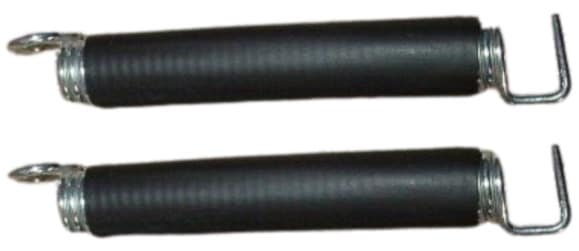
Heat shrink tubing, commonly used for insulating wires, can also be used to reduce tremolo spring noise. There are many size options, so make sure to get the one that will result in a tight fit once heated. But not tight enough to hinder the spring from stretching.
Steps:
- Insert pieces of heat shrink tubing into the spring hooks.
- Alternatively, apply a product called plastic-dip, which hardens into a flexible plastic coating, onto the springs.
If using plastic dip, try and apply it with the springs stretched out. You also want to try and apply it anywhere there will be friction. It will prevent creaking noises if used correctly. One problem with it, however, is it will eventually break down as the springs are used over time.
Packing Foam
Packing foam, often found in online delivery packages, can be used to dampen the noise from tremolo springs.
Steps:
- Insert small pieces of packing foam between the springs.
- Perform a flick test to check if any sound is still resonating from the springs.
Some players who use foam say that it helps with any hum or vibration. But again, any points of friction will still make noise if this is what you are experiencing. Also, if you use too much foam, it might make noise as the springs rub against it.
Electric Tape
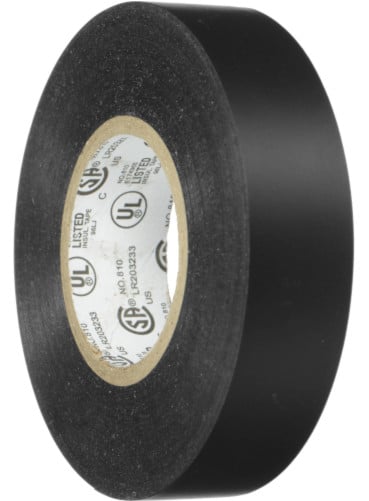
Electric tape can be used to prevent the springs from directly hitting the metal plate, thus reducing the noise.
Steps:
- Wrap small pieces of electric tape around the springs.
- Perform a flick test to check if any sound is still resonating from the springs.
Most people have some electrical tape. If you do, this is a quick and easy method to try when you just want relief from that pesky noise!
Advanced Solutions to Tremolo Spring Noise
While the common solutions can effectively reduce tremolo spring noise, there are also advanced solutions that offer a more permanent fix. One such solution is the use of noiseless springs.
Noiseless Springs
Noiseless springs are a modern innovation in the world of guitar mechanics. They are designed with a special polymer that helps to eliminate the unwanted noises that traditional tremolo springs can produce.
Benefits of Noiseless Springs:
- Noise Reduction: Noiseless springs are designed to eliminate any sounds that result from tension on the springs. This includes sounds that are picked up by the pickups, which can cause a guitar equipped with a tremolo to emit unpleasant sounds.
- High Volume Performance: These springs are coated with a substance that eliminates noise even at higher volumes. This makes them particularly useful when recording music in a studio.
- Compatibility with Heavy Gauge Strings: If you’re a professional player who prefers heavy gauge strings, noiseless springs can be a great choice. They allow you to use fewer springs without complicating the setup.
These are the best way to eliminate all sorts of tremolo spring noises. The polymer coating also works great for creaks at the body claw and more. But most guitars do not come with them from the factory.
Just make sure you understand what tremolo system you have. Like distinguishing between a 2 and 6 point tremolo system.
Choosing the Best Tremolo Springs
The choice of tremolo springs can significantly impact the noise produced by your guitar. Here are some factors to consider when choosing tremolo springs and some recommendations for the best ones.
Factors to Consider When Choosing Tremolo Springs
- Material: Springs are typically made of steel. The quality of the steel can determine the amount of tension the springs can withstand. High-quality steel can endure significant tension, leading to less noise production.
- Size: Springs come in different sizes. Depending on the design of your guitar, you might need longer or shorter springs.
- Tension: Some springs have a higher tension than others. Some people find a lower tension with more springs helps with tone and functionality.
Recommendations for the Best Tremolo Springs
Here is what I recommend for quality tremolo spring upgrades.
Floyd Rose Springs
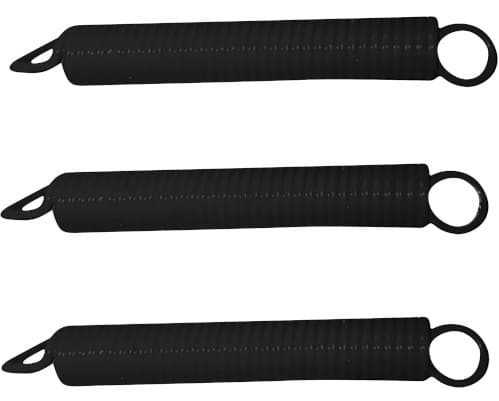
Floyd Rose offers springs of the same length and tension, which can help with consistent pitch return. They are noiseless, coated springs that help with a crisper sound and more sustain. Upgrading your claw and blocks to brass will help even more!
Ibanez Springs
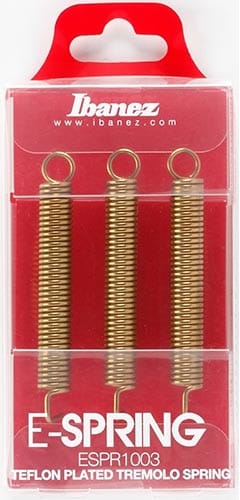
Ibanez brand offer longer size springs, which can be beneficial for guitars with unique designs. They are also Teflon coated to prevent any friction noise. It also helps to deal with the hollow hum that non-treated springs cause.
Spring Claw Upgrade
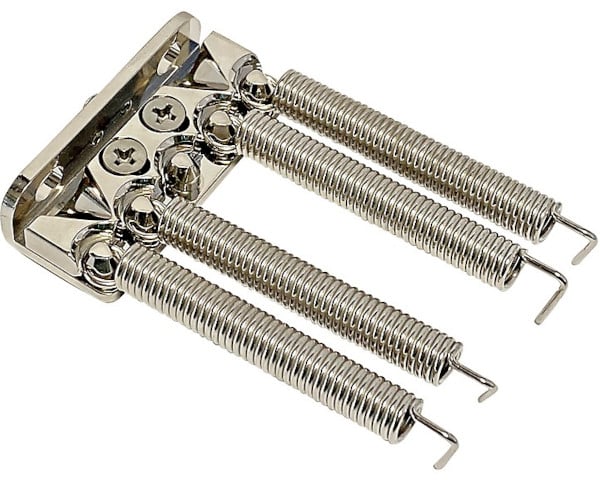
Another great upgrade that I have been using in my guitars is the AxLabs locking claw. It replaces the flimsy claw that comes stock in most guitars with this rigid body. Not only does it help to better position the springs, but it helped with tone and sustain. It’s pricey, but was a great upgrade!
Conclusion
Tremolo spring noise, while a common issue among guitarists, is not an irreversible problem. With a clear understanding of the causes and a few solutions at your disposal, you can effectively tackle this issue and restore the sounds of your guitars.
From the simplicity of using a piece of cloth or rubber tubing to the advanced technology of noiseless springs, each solution offers a unique approach to mitigating tremolo spring noise.
The choice of solution depends on your specific issue, the guitar’s design, and your budget.
Remember, the journey to a noise-free guitar may require some trial and error, but it’s well worth the effort. So, don’t let tremolo spring noise dampen your passion for music.
Instead, use it as an opportunity to learn more about your instrument and improve your guitar-playing experience.

